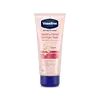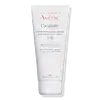What's inside
What's inside
 Benefits
Benefits

 Concerns
Concerns

 Ingredients Side-by-side
Ingredients Side-by-side

Water
Skin ConditioningParaffinum Liquidum
EmollientDimethicone
EmollientStearic Acid
CleansingGlycerin
HumectantGlycol Stearate
EmollientTriethanolamine
BufferingGlyceryl Stearate
EmollientPhenoxyethanol
PreservativePetrolatum
EmollientCetyl Alcohol
EmollientMagnesium Aluminum Silicate
AbsorbentMethylparaben
PreservativeCarbomer
Emulsion StabilisingParfum
MaskingDisodium EDTA
Stearamide Amp
Hydrolyzed Keratin
HumectantWater
Skin ConditioningParaffinum Liquidum
EmollientMyreth-3 Myristate
EmollientPEG-45/Dodecyl Glycol Copolymer
Emulsion StabilisingDimethicone
EmollientAluminum Sucrose Octasulfate
Skin ConditioningOctyldodecanol
EmollientPEG-7 Glyceryl Cocoate
EmulsifyingAluminum Starch Octenylsuccinate
AbsorbentGlycerin
HumectantBeeswax
Emulsion StabilisingCetyl Alcohol
EmollientCopper Sulfate
Skin ConditioningDimethiconol
EmollientDisteardimonium Hectorite
StabilisingGlyceryl Stearate
EmollientMagnesium Sulfate
Phenoxyethanol
PreservativeSodium Benzoate
MaskingXanthan Gum
EmulsifyingZinc Sulfate
AntimicrobialWater, Paraffinum Liquidum, Myreth-3 Myristate, PEG-45/Dodecyl Glycol Copolymer, Dimethicone, Aluminum Sucrose Octasulfate, Octyldodecanol, PEG-7 Glyceryl Cocoate, Aluminum Starch Octenylsuccinate, Glycerin, Beeswax, Cetyl Alcohol, Copper Sulfate, Dimethiconol, Disteardimonium Hectorite, Glyceryl Stearate, Magnesium Sulfate, Phenoxyethanol, Sodium Benzoate, Xanthan Gum, Zinc Sulfate
 Reviews
Reviews

Ingredients Explained
These ingredients are found in both products.
Ingredients higher up in an ingredient list are typically present in a larger amount.
Cetyl Alcohol is a fatty alcohol. Fatty Alcohols are most often used as an emollient or to thicken a product.
Its main roles are:
Though it has "alcohol" in the name, it is not related to denatured alcohol or ethyl alcohol.
The FDA allows products labeled "alcohol-free" to have fatty alcohols.
Learn more about Cetyl AlcoholDimethicone is a type of synthetic silicone created from natural materials such as quartz.
What it does:
Dimethicone comes in different viscosities:
Depending on the viscosity, dimethicone has different properties.
Ingredients lists don't always show which type is used, so we recommend reaching out to the brand if you have questions about the viscosity.
This ingredient is unlikely to cause irritation because it does not get absorbed into skin. However, people with silicone allergies should be careful about using this ingredient.
Note: Dimethicone may contribute to pilling. This is because it is not oil or water soluble, so pilling may occur when layered with products. When mixed with heavy oils in a formula, the outcome is also quite greasy.
Learn more about DimethiconeGlycerin is already naturally found in your skin. It helps moisturize and protect your skin.
A study from 2016 found glycerin to be more effective as a humectant than AHAs and hyaluronic acid.
As a humectant, it helps the skin stay hydrated by pulling moisture to your skin. The low molecular weight of glycerin allows it to pull moisture into the deeper layers of your skin.
Hydrated skin improves your skin barrier; Your skin barrier helps protect against irritants and bacteria.
Glycerin has also been found to have antimicrobial and antiviral properties. Due to these properties, glycerin is often used in wound and burn treatments.
In cosmetics, glycerin is usually derived from plants such as soybean or palm. However, it can also be sourced from animals, such as tallow or animal fat.
This ingredient is organic, colorless, odorless, and non-toxic.
Glycerin is the name for this ingredient in American English. British English uses Glycerol/Glycerine.
Learn more about GlycerinGlyceryl Stearate is a mix of glycerin and stearic acid.
It is used to stabilize the mixing of water and oil ingredients. By preventing these ingredients from separating, it can help elongate shelf life. It can also help thicken the product's texture.
As an emollient, it helps soften skin and supports barrier-replenishing ingredients.
In cosmetics, Glyceryl Stearate is often made from vegetable oils or synthetically produced.
This ingredient may not be fungal-acne safe
Fun fact: The human body also creates Glyceryl Stearate naturally.
Learn more about Glyceryl StearateParaffinum Liquidum is also known as liquid paraffin. It is a type of highly refined mineral oil.
Like other oils, Paraffinum Liquidum has emollient properties. Emollients help soothe and soften the skin. By creating a barrier to trap moisture within, emollients help keep your skin hydrated.
Paraffinum Liquidum does not irritate the skin and is non-comedogenic.
Learn more about Paraffinum LiquidumPhenoxyethanol is a preservative that has germicide, antimicrobial, and aromatic properties. Studies show that phenoxyethanol can prevent microbial growth. By itself, it has a scent that is similar to that of a rose.
It's often used in formulations along with Caprylyl Glycol to preserve the shelf life of products.
Water. It's the most common cosmetic ingredient of all. You'll usually see it at the top of ingredient lists, meaning that it makes up the largest part of the product.
So why is it so popular? Water most often acts as a solvent - this means that it helps dissolve other ingredients into the formulation.
You'll also recognize water as that liquid we all need to stay alive. If you see this, drink a glass of water. Stay hydrated!
Learn more about Water